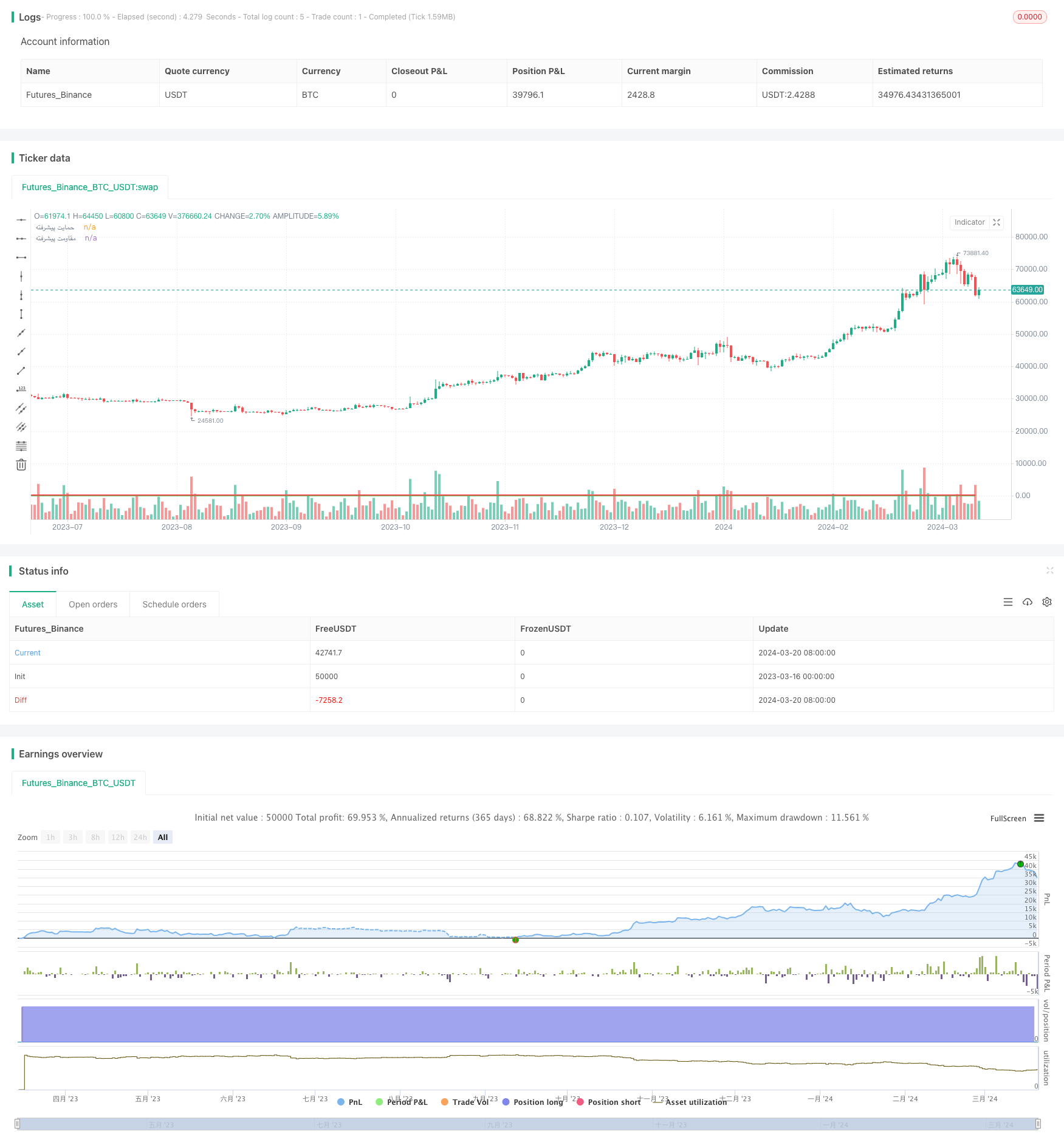
概述
支撑阻力-心理情绪-烛心反馈-资金管理策略是一个基于技术分析和资金管理的量化交易策略。该策略综合考虑了市场的支撑阻力位、交易者心理情绪、价格反馈信号以及严格的资金管理规则,力求在把控风险的同时获取稳健收益。
策略原理
该策略的核心逻辑包括以下几个部分:
支撑阻力位识别:通过
input函数输入预定义的支撑位和阻力位价格。当市场价格突破这些关键位置时会形成重要的交易信号。交易者心理情绪:引入多头情绪指标
bullPsych和空头情绪指标bearPsych来衡量市场情绪。当价格超过多头情绪阈值时倾向做多,低于空头情绪阈值时倾向做空。烛心反馈条件:
feedbackCond作为反馈信号,在价格触及支撑阻力位且符合情绪条件后,根据反馈条件决定是否进场交易。风险回报比:
rewardRiskRatio定义了策略的目标收益与风险承受能力之间的比例关系。头寸规模:基于账户余额
strategy.equity以及每笔交易的风险比例riskPerTradePercent来动态计算每笔交易的头寸规模,实现风险的定量控制。进场信号:综合支撑阻力位突破、心理情绪指标以及烛心反馈条件,使用
strategy.entry函数实现做多和做空信号的捕捉。止盈止损:依据风险回报比动态计算止盈价格和止损价格。使用
strategy.exit函数进行条件触发退出,严格把控每笔交易的盈亏比例。可视化:使用
plot和plotshape函数在图表上绘制支撑阻力位线以及标记烛心反馈信号,为交易决策提供直观参考。
优势分析
支撑阻力-心理情绪-烛心反馈-资金管理策略的优势在于:
融合了技术分析要素与市场情绪因素,形成了多维度的综合交易逻辑,具有更强的适应性和稳健性。
烛心反馈条件的设置可以有效过滤噪音信号,提高信号的有效性。
固定风险回报比的头寸规模控制,使得策略在资金管理方面更加严谨,可以有效避免单次交易的过度风险暴露。
止盈止损位的动态计算使得每笔交易的盈亏比例是可控的,有利于长期稳健的资金曲线表现。
关键指标参数可以通过
input函数灵活调整,具有很强的可自定义性和可调优性。
风险分析
支撑阻力位的选取具有一定主观性,如果选取不当可能导致频繁误判。
市场情绪指标对于价格走势的指示性并非绝对,在市场极端状况下可能失效。
反馈信号的有效性依赖于烛心形态的可靠性,但在震荡行情中烛心信号质量可能下降。
固定风险回报比策略在行情大幅波动时可能错失更高的潜在收益。
针对上述风险,可以从以下方面进行优化和改进:
- 对于支撑阻力位,可以结合更多技术指标(如布林带、趋势线等)进行动态确认。
- 在极端市场情绪下,可以通过引入交易量指标等方式对情绪信号进行校准。
- 针对烛心反馈信号,可以通过引入多时间周期过滤来提升信号可靠性。
- 在风险可控的前提下,对于行情趋势较强的阶段可以适度提高风险回报比,争取更高收益。
优化方向
支撑阻力位的动态识别:固定的支撑阻力位输入可能无法很好地适应实时的市场变化。可以尝试引入一些自适应算法(如自适应均线、动态套利通道等),根据价格趋势和波动状况动态调整支撑阻力位,以提高关键位置判断的灵活性和准确性。
综合交易量指标:现有策略主要基于价格本身的信息进行判断,而交易量是另一个重要的市场信号。可以考虑将交易量相关指标(如量价趋势背离、OBV指标等)纳入交易逻辑之中,形成价量结合的多重验证,提高信号可靠性。
多空仓位的动态配置:目前策略对于多空方向的仓位配比是固定的,这种做法可能无法很好地适应趋势性行情。可以探索一些仓位动态调整的方法(如网格交易、行情跟踪模型等),根据价格走势和波动率等因素动态配置多空仓位比例,以更好地把握市场趋势性机会。
止盈止损阈值的优化:固定的止盈止损比例可能无法兼顾行情的差异性。可以尝试一些自适应的止盈止损算法(如移动止损、波动率止损等),根据价格的波动幅度和频率等特征动态调整止盈止损阈值,在控制风险的同时追求更高的盈利水平。
加入机器学习模型:传统的技术指标和规则虽然简单有效,但在应对市场复杂变化时可能存在局限性。可以考虑将一些机器学习模型(如支持向量机、决策树、神经网络等)引入策略框架,通过对历史数据的训练学习,挖掘更深层次的市场规律,辅助甚至替代部分传统交易规则,以提高策略的适应性和智能化水平。
以上优化方向可以根据实际需求和资源条件选择性的实施。通过不断的迭代优化,有望进一步提升策略的稳健性和盈利能力。
总结
支撑阻力-心理情绪-烛心反馈-资金管理策略是一个融合了多种技术分析要素和量化交易理念的综合性策略。它通过支撑阻力位、市场情绪、反馈信号、风险控制等多个维度的有机结合,构建了一套相对完整的交易逻辑和风险管理体系。同时,该策略在实现过程中也提供了较高的灵活性和可定制性,用户可以根据自身需求和市场特点进行参数优化和模块调整。
当然,任何策略都不可能做到完美无缺,在实际应用中必然会面临各种挑战和风险。支撑阻力位判断的有效性、市场情绪指标的可靠性、反馈信号的噪音干扰、风险模型的局限性等,都是需要在实践中不断优化改进的方面。通过引入动态阻力支撑位、交易量指标验证、仓位自适应配置、止盈止损动态优化以及机器学习等手段,可以在一定程度上提升策略的适应性和抗风险能力。
总的来说,支撑阻力-心理情绪-烛心反馈-资金管理策略为量化交易实践提供了一个较为简单实用的思路框架。在掌握核心原理的基础上,通过灵活的优化组合和严谨的实践检验,有望成为把握市场机会、控制交易风险的有效工具。量化交易的道路没有捷径,唯有坚持不懈的学习优化、审慎严谨的风险把控,才能在动荡多变的市场中立于不败之地。
/*backtest
start: 2023-03-16 00:00:00
end: 2024-03-21 00:00:00
period: 1d
basePeriod: 1h
exchanges: [{"eid":"Futures_Binance","currency":"BTC_USDT"}]
*/
//@version=5
strategy("S/R-Psych-Cndl-Fdbck-MM", shorttitle="SRPCFMM", overlay=true)
// تعریف حمایت و مقاومت پیشرفته
supportLvl = input(100, title="حمایت پیشرفته")
resistanceLvl = input(200, title="مقاومت پیشرفته")
// روانشناسی کندل
bullPsych = input(70, title="روحیه خریداری")
bearPsych = input(30, title="روحیه فروشنده")
// پولبک
feedbackCond = input(true, title="استفاده از پولبک")
// نسبت تارگت به ریسک
rewardRiskRatio = input(3, title="نسبت تارگت به ریسک")
// مدیریت مالی
riskPerTradePercent = input.float(1, title="ریسک برای هر معامله (%)", minval=0)
riskAmount = strategy.equity * (riskPerTradePercent / 100)
// Define entry conditions and feedback condition
longCond = close > supportLvl and close > bullPsych
shortCond = close < resistanceLvl and close < bearPsych
// Execute trade entry with feedback condition
if (longCond and feedbackCond)
strategy.entry("Long", strategy.long)
if (shortCond and feedbackCond)
strategy.entry("Short", strategy.short)
// محاسبه تارگت و استاپ لاس بر اساس نسبت تارگت به ریسک
targetPriceLong = close + (high - low) * rewardRiskRatio
stopPriceLong = close - (high - low) * (riskPerTradePercent / 100)
targetPriceShort = close - (high - low) * rewardRiskRatio
stopPriceShort = close + (high - low) * (riskPerTradePercent / 100)
// اجرای خروج از معامله با حمایت و مقاومت و تارگت و استاپ لاس
strategy.exit("Take Profit/Stop Loss", from_entry="Long", loss=supportLvl, profit=targetPriceLong)
strategy.exit("Take Profit/Stop Loss", from_entry="Short", loss=resistanceLvl, profit=targetPriceShort)
// نمایش خطوط حمایت و مقاومت در نمودار
plot(supportLvl, color=color.green, linewidth=2, title="حمایت پیشرفته")
plot(resistanceLvl, color=color.red, linewidth=2, title="مقاومت پیشرفته")
// نمایش حجم پیشرفته
plotshape(series=na, title="حجم پیشرفته", color=color.purple, style=shape.triangleup, location=location.abovebar, size=size.small)